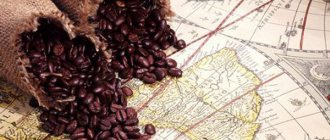It is impossible to imagine the modern world without coffee. The aromatic invigorating drink has firmly entered the cultural traditions of many countries and peoples. Wherever you find yourself, there is always the opportunity to get a cup of freshly brewed coffee, without which many cannot imagine starting the day. However, this was not always the case.
Where did the victorious march of coffee across countries and continents begin? So, the history of coffee is the most interesting.
Legends of the origin of coffee
Today there is no clear truth about the origin of coffee, we know that the origins of the homeland lie in Ethiopia, and there are several versions of its discovery, but there is one that I want to retell, about the shepherd Kaldi. It sends us back to the middle of the 9th century, where we first learned about the miracle of berries that give an unprecedented supply of vigor. At first, it was not people who recognized the remarkable effect, but goats, who turned out to be more inquisitive, and their shepherd, whose name was Kaldi, noticed the consequences. He noticed that after eating the berries, his goats became cheerful and began to jump wildly. Then he took the berries to the local monastery, where the monks tried them, and, having convinced themselves of the effect, began to use this decoction so as not to fall asleep during long night services.
There is also a well-known fact that during this period one of the African tribes used coffee berries with fat as an energy food, which adds credibility to this legend.
Modern history
The modern history of coffee is no less interesting than the ancient one, telling about its appearance, recipes and properties. This is the history of the emergence and development of different roasting techniques, the creation of unusual types of coffee drinks, brewing methods, special machines for preparation and related products. World leaders have also emerged, offering a wide range of products that have won love in many countries around the world.
Dozens of delicious drinks are prepared using roasted coffee beans.
Italians are considered coffee connoisseurs and the best specialists in the coffee business. The most famous brands, such as Lavazza and ILLi, come from Italy. There is even a roasting option for coffee beans called Italian, which means the strongest or blackest. Today they produce ground, instant, freeze-dried, bagged, and pod coffee intended for coffee machines. There are also many options for coffee-based drinks. The most famous of them are:
- espresso;
- Americano;
- cappuccino;
- mochaccino;
- look;
- latte and others.
In recent years, natural green coffee has been gaining popularity, which is not roasted in order to preserve more beneficial components, especially chlorogenic acid, which has revolutionized the ranks of everyone who wants to lose weight quickly. Another paradox in the market is a product called Luwak coffee. It is obtained from the excrement of a small animal that lives in Indonesia and loves to feast on fresh fruits of the coffee tree. The drink, prepared from grains that have passed through the animal’s digestive tract, according to experts, has the most wonderful taste. This is why Luwak has become the most expensive product of its kind.
If the origin of coffee as a fact is clarified, then the future history of this popular grain will surprise more than one generation of coffee lovers. Warm, cold, hot coffee drinks are products that will always attract a person with their smell and the expectation of a new portion of vigor and optimism.
Origins of cultural coffee consumption
What they didn’t do with coffee: they used it in medicine as a medicinal plant, soaked it in cold water for coffee decoctions, mixed it into food with fat, but they started frying and grinding only in the 13th century, at least the first mentions date back to this time . During that period, with the growing influence of Islam in the east, many began to follow Muhammad’s ban on wine and other alcohol, and coffee became an excellent alternative, which would later be called “Arabian wine.” By the way, the Arabian Peninsula gave Arabica coffee its legendary name.
History of coffee in Russia
Many believe that the custom of drinking coffee was introduced, among other reforms, by Peter the Great. However, this is not so: his father, Tsar Alexei Mikhailovich, was already a renowned coffee drinker and drank 4-5 cups, or even more, during the day. Since childhood, the king had poor health, and the court doctor advised him to drink “boiled coffee” as a cure for colds and headaches.
However, it was under Peter (I) that the custom of drinking coffee spread in the high society of the Russian Empire. In 1740, the popularity of the drink led to the opening of the first coffee house, where you could not only drink a cup or two of freshly brewed drink, but also stock up on beans for home consumption.
Nevertheless, coffee for a long time remained a “master’s” drink in our country, consumed mainly by representatives of the nobility. The merchant class preferred tea, while others simply did not have enough money to buy coffee beans. It is worth noting that they did not drink coffee, but ate it: until the beginning of the twentieth century, the stable expression “to take a bite of coffee” was preserved.
The origins of coffee as a business
The Muslims quickly realized that coffee would become an important export commodity and took control of it, which remained with them for 300 years. They took maximum measures to remain a monopoly: they strictly protected coffee plantations and prohibited visiting them, did not allow the export of coffee trees, and when exporting green raw materials, they scalded it in boiling water or partially fried it. Arabia became the only place in the world where coffee could be bought, and Turkey by the 15th century became the world's main distributor, conquering the markets of Persia, Yemen, Syria, Egypt, Greece, and by the 16th century it was already supplying coffee to Italy. By the way, the appearance of coffee in Italy was controversial; Catholics believed that it was the drink of the devil and petitioned Pope Clement to ban it. The pope wanted to approve the petition, but first try what he was going to ban. Having taken a sip, he immediately christened it, saying that the drink was too good to be drunk only by the Turks. So coffee was approved in Christianity.
Where did the word coffee come from?
The word "coffee" entered English in 1582 through the Dutch koffie, a loanword from the Ottoman Turkish qahwé, itself a loanword from the Arabic qahwah (قهوة).
The Arabic word qahwah originally referred to a type of wine, the etiology of which is given by Arab lexicographers as a derivative of the verb qahā (قها, "to lack hunger") due to the drink's reputation as an appetite suppressant.
The word qahwah sometimes alternatively comes from the Arabic quwwa ("strength, energy") or from Kaffa, a medieval kingdom in Ethiopia from which the plant was exported to Arabia. However, all etiologies of qahwah have been disputed.
The name qahwah is not used for the berry or plant, which is known in Arabic as bunn, and in Somali and Romo as būn. Semitic languages had the root qhh, "dark color", which became the natural designation for the drink. According to this analysis, the form qahwah (also meaning "dark-colored, dull, dry, sour") was probably chosen to parallel khamr (خمر, "wine"), and originally meant "dark".
Arab Bedouin with a cup of coffee, photo 1930
The first coffee shop in the world and its followers
The first coffee shop in the world opened in 1475 in Constantinople, now the capital of Turkey - Istanbul. The Turks have made a significant contribution to the development of world coffee culture, including consumption, because until now, Turkish coffee is one of the most popular ways of brewing at home.
At the beginning of the 16th century, the door to Europe opened for coffee, and by 1670 coffee houses had appeared in almost every major city, and European countries adapted this phenomenon into culture in different ways:
- In England, coffee shops became a place where pressing issues of the day were discussed, a kind of public forum; they were also called “penny universities,” since anyone with one penny could buy a cup of coffee and join the discussion. Women were not allowed into these coffee shops, which was the beginning of protests, since men spent a lot of time in them. The protests were unsuccessful, and by the end of the 16th century there were about 300 coffee houses in London.
- In France, on the contrary, coffee culture took a different path, these were places where men and women met, there was a rich interior around them, and musicians played. It was here that coffee with milk, which the French called café au lait, first became popular.
- In Italy, the first coffee shop appeared in 1647, in Venice. It was the Italians who in the 20th century invented the espresso coffee machine, which would become a revolution in preparation and form the basis for everyone’s favorite coffee recipes: cappuccino and latte. By the way, many people believe that coffee itself grows in Italy. This is a misconception, they make good equipment for its preparation, and we will tell you where coffee grows and its current geography in the following articles.
- In America, the first coffee shop opened in Boston in 1670, but Americans drank more tea than coffee. Everything changed in 1773, when the Boston Tea Party occurred, it was a protest against an increase in the tax on tea by England. This was the turning point when Americans abandoned tea in favor of coffee, after which it became the national drink here too.
Turkish coffee shops
Coffee beans were brought to Turkey in the 16th century, but at first the bitter drink did not cause much enthusiasm. In the middle of the century, an embassy from Yemen arrived to Sultan Suleiman the Magnificent. Among the gifts, the envoy brought a bag of selected coffee and taught how to properly brew the aromatic drink. The Sultan and his beloved wife, the beautiful Hurrem, were delighted. Following them, the custom of drinking coffee was adopted first by the courtiers, then by ordinary townspeople.
In 1654, the doors of the first coffee shop opened to everyone in Istanbul, and soon similar establishments were opened in all areas of the city. Visitors sat on comfortable cushions, talked, smoked a hookah, and the servants, right before their eyes, brewed new portions of the drink in copper cezves. Soon the technology was brought to perfection, and today we use the same recipes that were in use four hundred years ago.
In Turkey, coffee became so popular that a bride who did not know how to prepare the drink was considered ill-prepared for marriage. If after the wedding a woman discovered that her husband did not have enough money to provide her with coffee, she had every right to file for divorce.
Loss of monopoly on coffee production
The Arabs and Turks had a monopoly on coffee production for a long time, but everything did not last forever, especially since there was one European country that perfectly mastered shipbuilding and traded with the whole world. Once, she already managed to bypass the Turks in the lucrative spice trade by finding sea routes that passed through territories not subject to Turkey. These were the Dutch, and they were also interested in the coffee trade.
At the end of the 17th century, an event occurred that changed coffee history: a ship from Amsterdam arrived at the port of Mocha, from which tons of green coffee had been shipped for 300 years. There were sailors on the ship who were able to buy a live coffee tree from the farmer. Having carried it secretly onto the ship, they did not yet fully realize what they had done, because this was the starting point in the loss of the monopoly on coffee production.
The expansion of this stolen coffee tree began, first spreading to the Dutch colonies in Indonesia, then the French in the Caribbean, and then overtook Brazil, which would later become the largest coffee producer in the world.
Development of coffee plantations
For many centuries, due to its high cost, coffee remained inaccessible to ordinary people, and its cultivation was extremely profitable.
The first coffee plantations appeared in Yemen. The rulers of this country quickly realized that a monopoly on coffee was an incredibly profitable business, and they forbade, on pain of death, the export of seedlings or raw, unroasted beans from the country.
However, any prohibitions are overcome sooner or later, especially if it promises fabulous benefits. In 1650, the Indian Muslim Baba Budan managed to steal some green grains. In his homeland, he founded the first coffee plantation outside the Arabian Peninsula.
About forty years later, his “feat” was repeated by Dutch merchants, who took the seedling to their tropical colonies, establishing Mocha coffee plantations in Ceylon and the island of Java.
In tropical climates, coffee trees produce up to four harvests a year, bringing considerable income to their owners.
At the beginning of the 18th century, France joined the club of coffee-growing countries. A certain officer Mathieu de Cleix, by order of the king, transported several seedlings from His Majesty’s personal greenhouse to the Antilles, which were then French colonies. The swim was long and difficult. Subsequently, de Cleix recalled that at the end of the journey he even had to cut the ration of drinking water for the crew so that he had something to water the trees.
However, within a few years, the coffee plantations of the island of Martinique began to generate huge income, and soon coffee cultivation began in Jamaica, Haiti, Cuba and other islands of the archipelago.
From Martinique and Dutch Guiana (now Suriname), coffee plantations spread to the New World.
Some stories today look like an exciting detective story. Thus, a coffee seedling came to Brazil thanks to the adventurism of a certain Brazilian colonel Francisco de Melo Palet. Arriving in Guiana for negotiations on a border dispute, he started a love affair with the wife of the French governor and on one of the dates he told the lady that he dreamed of establishing a coffee plantation in Brazil.
There was no question of legally purchasing trees - export was strictly prohibited, and the plantations were guarded by armed detachments. However, the woman in love found a way out - on the day of separation she gave her lover a huge bouquet in which a precious seedling was hidden among the lush flowers. Thus, thanks to a romantic history, Brazil became the world leader in coffee cultivation.
In the 19th century, European industrialists began to grow Mokka coffee and other varieties in some Central African countries - Kenya and Tanzania. Despite the fact that these countries are located only a few hundred kilometers from the birthplace of coffee - Ethiopia, seedlings for the plantations had to be imported from Brazil. Having traveled around the world, coffee trees returned to their native Africa.
Coffee realities today
Undoubtedly, the history of coffee continues, and a lot has changed since it was opened to the world: a hobby has grown into a serious business, engineers have invented cool equipment for roasting and preparation, scientists have created instant coffee and decaffeinated coffee, industry professionals find new ways every year. brewing, and restaurateurs are opening new formats of coffee shops. Today it is difficult to imagine a world without coffee, and for many people their normal day would be without a cup of the invigorating drink.
In Russia, coffee consumption is growing every year, local roasters are opening, which allows many to drink fresh product, and in principle, the market is shifting towards freshly roasted coffee, as an alternative to instant or imported coffee. Affordable methods of brewing coffee at home are appearing, people are beginning to understand that for a tasty cup you don’t need an expensive coffee machine, but rather a simple French press or simply brew it in a cup. Of course, in terms of coffee consumption per capita, we are inferior to many Western countries, led by Finland, where each resident drinks about 13 kilograms annually. But we know that nothing lasts forever, because once upon a time only goats could afford to enjoy coffee.
Coffee and modernity
Currently, coffee is the most popular drink in the world, leaving tea, cocoa and other analogues far behind the flag. Every day, the world's population drinks approximately 2.25 billion cups of coffee, and annual consumption is approaching a trillion cups.
About a third of this amount is drunk by residents of Europe, the United States accounts for 18% of global consumption, and Brazil completes the top three coffee-drinking countries with 15%.
In Russia, for many years, coffee was much less popular compared to tea, but today both drinks are in approximately equal demand.
Coffee machines
A huge impetus to the growth of the popularity of coffee was the invention of the coffee machine. The first unit was manufactured in Milan, Italy in 1901. It was a huge tank of complex design: finely ground coffee powder was poured inside, then a stream of boiling water was passed through it under high pressure. The coffee machine made it possible to quickly prepare coffee for everyone in small cafes and eateries.
Coffee machines were improved, decreased in size, became more convenient and “more mobile”. The principle of their operation remains unchanged - boiling water passes through the ground coffee.
Instant coffee
At the same time as coffee machines, instant coffee was invented. The method of its manufacture was invented by Satori Kano, an American engineer of Japanese origin.
Initially, the drink, to put it mildly, did not impress with its taste and aroma, however, due to its ease of preparation, it found use in the army diet. During the First World War, millions of soldiers from different countries became accustomed to instant coffee. After the end of hostilities, they did not want to give up their usual drink.
Gradually, manufacturing technology has improved, and modern manufacturers offer powdered coffee of quite decent taste.
Decaffeinated coffee
Concern for health has led to the emergence of a new product - decaffeinated coffee. Its creation was helped by an accident: a ship with a load of coffee beans was caught in a storm, and most of the bags were flooded with sea water. After testing, it turned out that the beans retained the aroma, but at the same time almost all the caffeine was washed out of them.
German chemist Ludwig Roselius conducted a series of experiments and developed a technology that allows caffeine to be removed without compromising the taste of the drink. However, it later turned out that the method chosen by Roselius could harm the health of consumers, and today more reliable technologies are used to extract caffeine.
It is impossible to imagine the modern world without coffee. This magnificent drink is drunk in the luxurious palaces of billionaires and in the poor Brazilian favelas, in equatorial countries and at the North Pole. Billions of people start their day with a cup of coffee, the enchanting aroma of which serves as a charge of good mood, vigor and energy for the entire next day.
Now, when chatting with friends in a coffee shop, you can share facts about the history of coffee - interesting and exciting!
So black or black?
For a long time, the phrase “black coffee” indicated illiteracy in a person, since the word “coffee” in the native language is not neuter, but masculine. But language is a living organism, and if it does not change and evolve, it risks joining the ranks of “dead languages” such as Latin or Ancient Greek. In the process of its evolution, the language becomes simpler and adapts to modern realities. Thus, some words become archaisms, since the concepts they denote disappear from everyday life, while others, on the contrary, appear or are borrowed from other languages in order to denote innovative products or phenomena. In addition, in the process of linguistic evolution, the boundaries between the language of the upper strata of society and the “common people” are erased, and this is not surprising, because the division of society into classes and castes is also no longer relevant. Well, except that Royal English still exists at the court of the Queen of Great Britain. What do these linguistic features have to do with coffee? It turns out that it is the most direct. After all, since 2002, grammar has officially assigned coffee not only the masculine, but also the neuter gender, and today, if someone says that he wants black or hot coffee, it is no longer possible to blame him for lack of education.
But, there are certain limitations. Firstly, if you still want to seem like a person who knows how to express themselves competently and beautifully, then it is better to order black coffee, that is, use the masculine gender. Secondly, the neuter gender for the word “coffee” is only allowed in spoken language. And if during a conversation the mentioned neuter type of drink may not be noticed, then when writing it will be a gross mistake, fraught with a bad grade for students, and for an adult - with the stigma of “illiterate”. Return to content
Ethiopia - the birthplace of coffee
The birthplace of coffee is Ethiopia.
It was from this distant African country that the coffee plant spread throughout the world.
The origin of the word coffee is explained by several theories:
- The properties of coffee beans were first noticed by a shepherd in the city of Kaffa. The consonance of words is difficult to reject, so most historians are inclined towards this option.
- The name comes from the Arabic “kava”, which means “exciting” or “preventing sleep”.
- Borrowed from the name of the wine variety "Kava", which was made by the Ethiopians, and also had tonic properties.
There are several less popular explanations about the origin of the word "coffee".
Earth's Coffee Belt
The history of the development of the coffee industry is directly related to the climatic characteristics of the countries where this plant is grown. Coffee trees are quite whimsical. For growth and fruiting, only a warm and humid climate is suitable for them. The optimal year-round temperature for this crop is considered to be +18…22˚С.
Coffee trees in the world grow in equatorial countries. If you look at a schematic image of a world map, you can see a clear stripe that highlights areas with ideal temperature conditions. This strip is called the Earth's coffee belt . It includes the following countries:
- Central and South America - Brazil, Colombia, Mexico, Guatemala, Costa Rica, Nicaragua.
- Africa – Kenya, Ethiopia, Tanzania, Zimbabwe.
- Asia – Yemen, India.
- Oceania - Java, Sumatra, Sulawesi.
The coffee belt includes 80 countries, but not all export beans.
Exporting countries differ in the varieties of coffee trees they grow. Arabica grows only in high mountain areas, but robusta also thrives in lower areas.
Australia harvests coffee mechanically
Australia is a small coffee producer with few products to export, but its coffee history dates back to 1880, when the first 500 acres of land began to be developed in the area between northern New South Wales and Cooktown, Queensland. Today there are several Arabica coffee producers in Australia that use a mechanical harvesting system invented in 1981.
modern coffee machines Post Views: 4,890
The first records where coffee is mentioned
The earliest mention of coffee, noted in writing by the coffee trader Philippe Sylvestre Dufour, is a reference to the work of a 10th century AD Persian physician. Muhammad ibn Zakariya al-Razi, known as the Razi of the West (Persian polymath, physician, alchemist, philosopher and important figure in the history of medicine). But more definite information about the preparation of a drink from roasted coffee berries dates back several centuries later.
One of the most important records on coffee was made by Abd al-Qadir al-Jaziri, who in 1587 wrote a work tracing the history and legal disputes about coffee entitled Umdat al-safwa fi hill al-Kahwa عمدة الصفوة في حل القهوة.” He reported that Sheikh Jamal al-Din al-Dhabhani (d. 1470), Mufti of Aden, was the first to adopt coffee (around 1454).
Coffee was also noted in Aleppo by the German botanist Leonhard Rauwolf, the first European to mention it in 1573.
Mocha coffee beans from Yemen
Stealing for good
Once upon a time there lived a Hindu, Baba Budan. At the end of the 17th century, he decided to go to Hajj. And when he returned from Mecca, he took fresh coffee beans with him. Well, he grabbed it... stole it. And then he secretly planted them at home. So his star slowly rose. And today Hindus love Baba Budan, calling him a national hero.
A few years passed when merchants from Holland came to India. On the way back, they took coffee seedlings (either as a gift, or they also stole them - history is silent), and planted an entire plantation on the island of Java. For 20 years, the coffee that was sold throughout the European continent was grown in these colonies.
Brazil is the second home of coffee
Coffee trees can only grow in countries with hot climates. Brazil was ideally suited to all climatic conditions, but it was impossible to obtain plant seedlings. European colonialists jealously guarded their plantations, stopping any attempts to steal precious seeds.
The Portuguese came up with more and more new plans for obtaining seedlings or simply unprocessed seeds. One day they sent their ambassador on a secret mission to Guiana. It is unknown how the fate of Brazil would have developed in the future if it had not been for the passion that broke out between the wife of the governor of Cayena and the young ambassador. The woman in love helped the Portuguese and provided him with valuable samples of the plant.
Already in the 18th century, Brazil planted vast territories with coffee seedlings. Today it produces a third of the coffee supplied to world markets. The total size of coffee plantations is equal in area to all European countries.
Some more facts about this wonderful drink
- Instant coffee, which is now available and distributed throughout the world, was invented by George Washington back in 1910.
- In ancient times, the drink was believed to have medicinal properties. Interesting facts about coffee are known. For example, the fact that it was used as medicine to prevent diseases of the stomach and intestines, to calm the nervous system.
- There was a period when the drink was prohibited, for example, by priests. They believed that people were becoming dependent on this drink, so they were categorically against its use.
- Caffeine is on the list of prohibited substances contained in the body of athletes. Therefore, if it is detected, the competitor will not undergo doping control.
- Modern doctors deny that coffee increases blood pressure. Although this is precisely the opinion that doctors held for a long time and forbade hypertensive patients from drinking this drink.
- Since coffee has a diuretic effect, it therefore prevents fluid retention in the body. Excessive consumption can lead to dehydration.
- In one of the small towns in England, coffee is used as fuel. A power plant was built there, which requires coffee grounds to operate.
- Alcohol is prohibited for Muslims, so they replace it with coffee.
- Excessive consumption of the drink interferes with the absorption of calcium, and can also lead to insomnia and irritability.
- In Arab countries, making coffee is a man's responsibility. If he does not do this, it may lead to divorce.
- Famous people who were coffee drinkers include the great composer Beethoven and the philosopher Voltaire.
- The thicket has been used for fortune telling since ancient times and to this day.
- Drinking an invigorating drink daily helps improve memory.
- Coffee can be used for household purposes. It is suitable for cleaning pots and washing dishes. You can also renew leather clothes and make them shine by wiping them with a swab dipped in strong coffee.
Where do coffee beans come from?
The berries grow on trees that can reach a height of 9 meters. Trees react negatively to temperature changes. Therefore, they grow in warm climates with stable weather conditions. However, most often they are made lower to make it convenient to pick the fruits.
Large white fragrant flowers appear on the tree first, which then ripen into red berries, although these may vary slightly in color depending on the type of tree. There is grain inside. It is then processed, ground into powder and a flavored drink is prepared.











